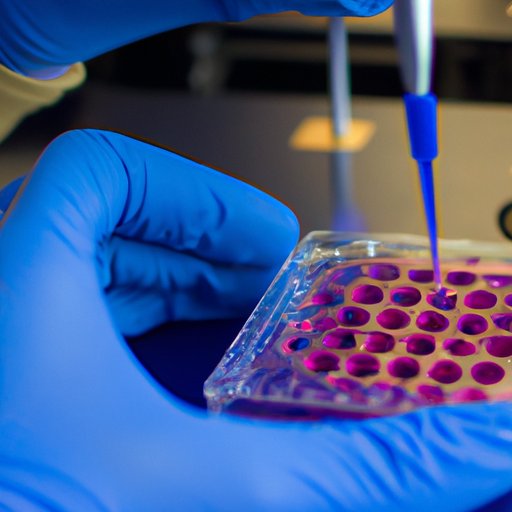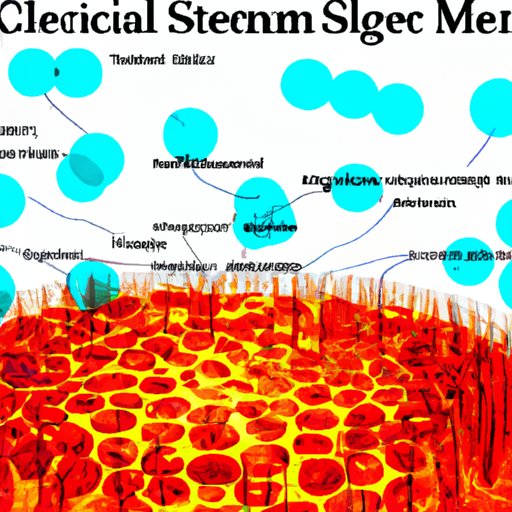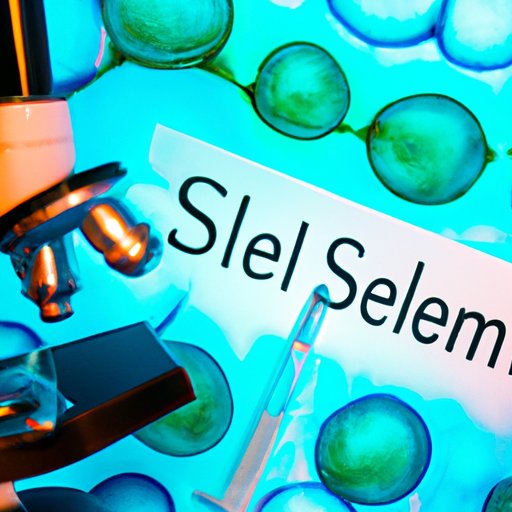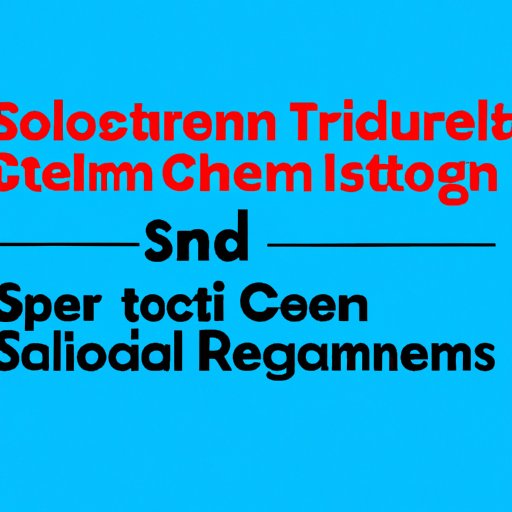Introduction
Stem cell technology has been making headlines in recent years due to its potential to revolutionize the field of medicine. This cutting-edge technology involves the study and manipulation of stem cells—undifferentiated cells that have the potential to develop into various types of cells in the body. Scientists are currently exploring the possibilities of using stem cell technology to create treatments for a variety of diseases and disorders.
In this article, we will explore the basics of stem cell technology and examine the potential benefits and drawbacks of this revolutionary field of research. We will also investigate the ethical debate surrounding its use and analyze the potential benefits of stem cell technology.

Exploring the Basics of Stem Cell Technology
Before delving into the potential benefits and drawbacks of stem cell technology, it is important to understand the basics of this revolutionary field of research.
What is a stem cell?
A stem cell is an undifferentiated cell that has the potential to develop into various types of cells in the body. Stem cells can be found in both embryos and adult tissues, and they can be used to regenerate and repair damaged tissue.
Different types of stem cells
There are two main types of stem cells: embryonic and adult. Embryonic stem cells are derived from embryos and have the ability to differentiate into any type of cell in the body. Adult stem cells, on the other hand, are found in adult tissues and specialize in regenerating specific types of cells in the body.
How do scientists use stem cells in research?
Scientists use stem cells in research to explore how cells develop and how they interact with other cells in the body. This can help researchers better understand how diseases and disorders develop and how they can be treated. Additionally, stem cells can be used to create new treatments for diseases and disorders that were previously untreatable.

How Stem Cell Research is Changing Medicine
The potential applications of stem cell technology are vast and far-reaching. In recent years, scientists have made some major breakthroughs in the field of stem cell research, leading to a number of potential treatments for diseases and disorders that were previously untreatable.
Examples of medical breakthroughs involving stem cells
One of the most notable examples of a medical breakthrough involving stem cell technology is the creation of induced pluripotent stem cells (iPSCs). iPSCs are stem cells that have been reprogrammed from mature cells to act like embryonic stem cells. These cells can then be used to create treatments for a variety of diseases and disorders.
Potential treatments that may be developed using stem cells
The potential treatments that could be developed using stem cell technology are numerous. Some of the most promising potential treatments include treatments for cancer, Alzheimer’s disease, Parkinson’s disease, heart disease, diabetes, and spinal cord injuries. Additionally, stem cells may be used to create personalized therapies for individual patients.
Examining the Pros and Cons of Stem Cell Technology
As with any new technology, there are both advantages and disadvantages to using stem cell technology. It is important to consider both the potential benefits and drawbacks of this revolutionary field of research before making any decisions about its use.
Advantages of stem cell technology
The potential benefits of stem cell technology are numerous. For example, stem cell research could lead to the development of treatments for diseases and disorders that were previously untreatable. Additionally, stem cell technology could be used to create personalized therapies for individual patients, as well as to advance regenerative medicine.
Disadvantages of stem cell technology
As with any new technology, there are potential drawbacks to using stem cell technology. For example, there are technical challenges associated with stem cell research, such as the difficulty of controlling the differentiation of stem cells. Additionally, there are logistical hurdles associated with stem cell research, such as the cost and complexity of obtaining and storing stem cells. Finally, there are ethical considerations associated with stem cell research, such as the potential for misuse or abuse of this technology.

Investigating the Ethical Debate Surrounding Stem Cell Technology
In addition to the potential benefits and drawbacks of stem cell technology, there is also an ethical debate surrounding its use. This debate centers around questions such as whether or not it is ethical to use embryos in stem cell research, and whether or not the potential benefits of stem cell research outweigh the potential risks.
Religious perspectives on stem cell technology
Many religions have strong opinions on the use of embryos in stem cell research. For example, the Catholic Church has spoken out against the use of embryos in research, while the United Methodist Church has expressed support for the use of adult stem cells in research. Other religious groups have taken a more neutral stance on the issue.
Moral implications of stem cell research
In addition to religious perspectives, there are also moral implications associated with stem cell research. One of the primary concerns is the potential for misuse or abuse of this technology. For example, some fear that stem cell research could lead to the creation of “designer babies” or the exploitation of vulnerable populations.
Legal issues surrounding stem cell technology
Finally, there are legal issues associated with stem cell technology. In the United States, federal funding for stem cell research is restricted by the Dickey-Wicker Amendment, which prohibits the use of federal funds for the creation of human embryos. Additionally, many states have their own laws governing the use of stem cells in research.
Analyzing the Potential Benefits of Stem Cell Technology
Despite the potential drawbacks of stem cell technology, there is no denying that this revolutionary field of research has the potential to improve the quality of human life. Here, we will examine some of the potential benefits of stem cell technology.
Potential treatments for diseases and disorders
The most obvious benefit of stem cell technology is the potential for developing treatments for diseases and disorders that were previously untreatable. For example, researchers have already made strides in creating treatments for cancer, Alzheimer’s disease, Parkinson’s disease, heart disease, diabetes, and spinal cord injuries using stem cell technology.
Development of personalized medicine
Stem cell technology could also be used to create personalized therapies for individual patients. This would allow doctors to tailor treatments to the specific needs of each patient, increasing the effectiveness of treatments and reducing the risk of side effects.
Advancement of regenerative medicine
Finally, stem cell technology could be used to advance regenerative medicine. Regenerative medicine is a branch of medicine that focuses on repairing or replacing damaged or diseased cells, tissues, and organs. Stem cell technology could be used to create treatments that could help regenerate damaged cells and tissues in the body.
Understanding the Current Limitations of Stem Cell Technology
Despite the potential benefits of stem cell technology, there are still some significant limitations that need to be addressed. Here, we will examine some of the current limitations of this revolutionary field of research.
Technical challenges in stem cell research
One of the primary challenges facing stem cell researchers is the difficulty of controlling the differentiation of stem cells. Differentiation is the process by which stem cells develop into different types of cells in the body, and controlling this process is essential for developing effective treatments. Additionally, there are challenges associated with obtaining and storing stem cells.
Logistical hurdles in stem cell research
Another challenge facing stem cell researchers is the cost and complexity of obtaining and storing stem cells. Obtaining high-quality stem cells can be expensive and time-consuming, and storing them requires specialized equipment and techniques.
Ethical considerations in stem cell research
Finally, there are ethical considerations associated with stem cell research. As mentioned above, there are questions surrounding the use of embryos in research, as well as the potential for misuse or abuse of this technology. Additionally, there are legal restrictions in place in many countries that govern the use of stem cells in research.
Conclusion
Stem cell technology holds a great deal of promise for improving the quality of human life. In this article, we explored the basics of stem cell technology and examined the potential benefits and drawbacks of this revolutionary field of research. We also investigated the ethical debate surrounding its use and analyzed the potential benefits of stem cell technology.
Overall, stem cell technology has the potential to revolutionize the field of medicine. However, there are still some significant challenges that need to be addressed before this technology can be used to its full potential. It is important to consider both the potential benefits and drawbacks of this revolutionary field of research before making any decisions about its use.
(Note: Is this article not meeting your expectations? Do you have knowledge or insights to share? Unlock new opportunities and expand your reach by joining our authors team. Click Registration to join us and share your expertise with our readers.)
